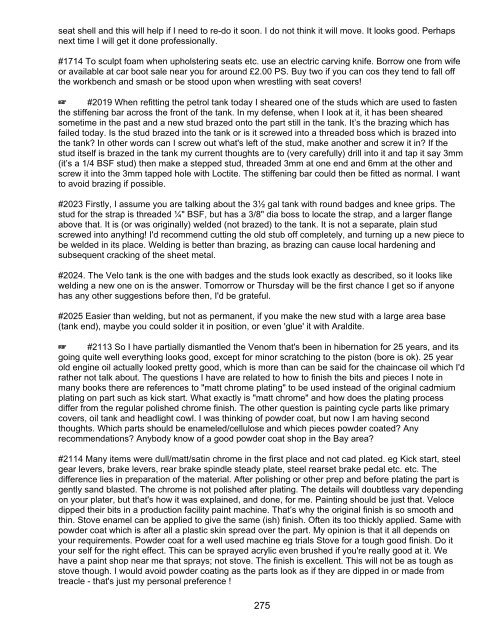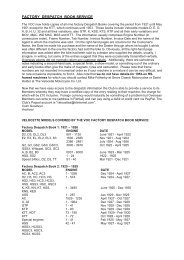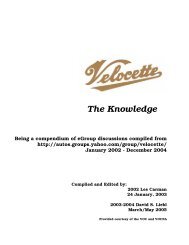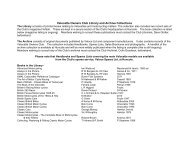The Knowledge - Velocette Owners Club
The Knowledge - Velocette Owners Club
The Knowledge - Velocette Owners Club
You also want an ePaper? Increase the reach of your titles
YUMPU automatically turns print PDFs into web optimized ePapers that Google loves.
seat shell and this will help if I need to re-do it soon. I do not think it will move. It looks good. Perhaps<br />
next time I will get it done professionally.<br />
#1714 To sculpt foam when upholstering seats etc. use an electric carving knife. Borrow one from wife<br />
or available at car boot sale near you for around £2.00 PS. Buy two if you can cos they tend to fall off<br />
the workbench and smash or be stood upon when wrestling with seat covers!<br />
L #2019 When refitting the petrol tank today I sheared one of the studs which are used to fasten<br />
the stiffening bar across the front of the tank. In my defense, when I look at it, it has been sheared<br />
sometime in the past and a new stud brazed onto the part still in the tank. It’s the brazing which has<br />
failed today. Is the stud brazed into the tank or is it screwed into a threaded boss which is brazed into<br />
the tank? In other words can I screw out what's left of the stud, make another and screw it in? If the<br />
stud itself is brazed in the tank my current thoughts are to (very carefully) drill into it and tap it say 3mm<br />
(it’s a 1/4 BSF stud) then make a stepped stud, threaded 3mm at one end and 6mm at the other and<br />
screw it into the 3mm tapped hole with Loctite. <strong>The</strong> stiffening bar could then be fitted as normal. I want<br />
to avoid brazing if possible.<br />
#2023 Firstly, I assume you are talking about the 3½ gal tank with round badges and knee grips. <strong>The</strong><br />
stud for the strap is threaded ¼" BSF, but has a 3/8" dia boss to locate the strap, and a larger flange<br />
above that. It is (or was originally) welded (not brazed) to the tank. It is not a separate, plain stud<br />
screwed into anything! I'd recommend cutting the old stub off completely, and turning up a new piece to<br />
be welded in its place. Welding is better than brazing, as brazing can cause local hardening and<br />
subsequent cracking of the sheet metal.<br />
#2024. <strong>The</strong> Velo tank is the one with badges and the studs look exactly as described, so it looks like<br />
welding a new one on is the answer. Tomorrow or Thursday will be the first chance I get so if anyone<br />
has any other suggestions before then, I'd be grateful.<br />
#2025 Easier than welding, but not as permanent, if you make the new stud with a large area base<br />
(tank end), maybe you could solder it in position, or even 'glue' it with Araldite.<br />
L #2113 So I have partially dismantled the Venom that's been in hibernation for 25 years, and its<br />
going quite well everything looks good, except for minor scratching to the piston (bore is ok). 25 year<br />
old engine oil actually looked pretty good, which is more than can be said for the chaincase oil which I'd<br />
rather not talk about. <strong>The</strong> questions I have are related to how to finish the bits and pieces I note in<br />
many books there are references to "matt chrome plating" to be used instead of the original cadmium<br />
plating on part such as kick start. What exactly is "matt chrome" and how does the plating process<br />
differ from the regular polished chrome finish. <strong>The</strong> other question is painting cycle parts like primary<br />
covers, oil tank and headlight cowl. I was thinking of powder coat, but now I am having second<br />
thoughts. Which parts should be enameled/cellulose and which pieces powder coated? Any<br />
recommendations? Anybody know of a good powder coat shop in the Bay area?<br />
#2114 Many items were dull/matt/satin chrome in the first place and not cad plated. eg Kick start, steel<br />
gear levers, brake levers, rear brake spindle steady plate, steel rearset brake pedal etc. etc. <strong>The</strong><br />
difference lies in preparation of the material. After polishing or other prep and before plating the part is<br />
gently sand blasted. <strong>The</strong> chrome is not polished after plating. <strong>The</strong> details will doubtless vary depending<br />
on your plater, but that's how it was explained, and done, for me. Painting should be just that. Veloce<br />
dipped their bits in a production facility paint machine. That’s why the original finish is so smooth and<br />
thin. Stove enamel can be applied to give the same (ish) finish. Often its too thickly applied. Same with<br />
powder coat which is after all a plastic skin spread over the part. My opinion is that it all depends on<br />
your requirements. Powder coat for a well used machine eg trials Stove for a tough good finish. Do it<br />
your self for the right effect. This can be sprayed acrylic even brushed if you're really good at it. We<br />
have a paint shop near me that sprays; not stove. <strong>The</strong> finish is excellent. This will not be as tough as<br />
stove though. I would avoid powder coating as the parts look as if they are dipped in or made from<br />
treacle - that's just my personal preference !<br />
275





